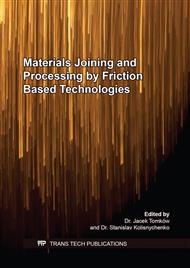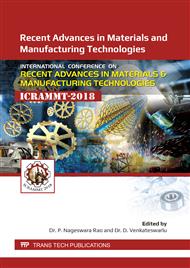p.839
p.846
p.852
p.858
p.864
p.870
p.876
p.882
p.889
Optimization of Friction Stir Processing Parameters for the Development of Cu-W Surface Composite
Abstract:
The present work focusses on improving the surface wear resistance of commerical pure copper by reinforcing tungsten particles through friction stir processing. Particularly this work adopts Taguchi’s experimental design to achieve minimum wear rate for Copper-Tungsten surface composite by optimizing the process parameters. The rotational and traverse speeds of tool and volume fraction of reinforcement (i.e. tungsten) are the chosen parameters for minimizing the wear rate. Taguchi L9 orthogonal array was used to design the experiments. The surfaces of the processed specimens were investigated by optical microscopy for the distribution of tungsten particles and sliding wear behavior was studied by conducting pin-on-disc method. It was observed from the optical micrographs that the reinforcement evenly dispersed in the processed zone. The measured hardness was 85% higher than the base metal for the specimen exhibited minimum wear rate. The effects of all three parameters on wear rate were studied. The minimum wear rate was achieved by using rotational and traverse speeds of tool, 1200rpm and 60mm/min, respectively. The amount of reinforcement required to achieve maximum wear resistance was 10%. Variance analysis showed that amount of reinforcement played a key role in determining the properties than the other parameters. Keywords: Cu-W composite, high strength high conductivity alloy, friction stir processing, Taguchi optimization
Info:
Periodical:
Pages:
864-869
Citation:
Online since:
August 2019
Price:
Сopyright:
© 2019 Trans Tech Publications Ltd. All Rights Reserved
Share:
Citation:



